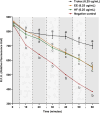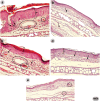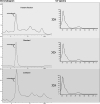Stachys byzantina K. Koch in the Treatment of Skin Inflammation: A Comprehensive Evaluation of Its Therapeutic Properties
- PMID: 39713701
- PMCID: PMC11656372
- DOI: 10.1021/acsomega.4c08830
Stachys byzantina K. Koch in the Treatment of Skin Inflammation: A Comprehensive Evaluation of Its Therapeutic Properties
Abstract
Stachys byzantina is a plant widely cultivated for food and medicinal purposes. Stachys species have been reported as anti-inflammatory, antibacterial, anxiolytic, and antinephritic agents. This study aimed to evaluate the anti-inflammatory potential of the ethanolic extract (EE) from the aerial parts of S. byzantina and its most promising fraction in models of acute and chronic inflammation, including a psoriasis-like mouse model. The EE was fractionated into hexane (HF), dichloromethane (DF), ethyl acetate (AF), and hydroalcoholic (HD) fractions. Screening for anti-inflammatory activity based on nitric oxide inhibition (IC50 μg/mL: HF 24.29 ± 5.87, EE 176.45 ± 18.65), hydroxyl radical scavenging (HF 3.89 ± 0.61, EE 6.38 ± 2.25), β-carotene/linoleic acid assay (HF 10.13 ± 3.81, EE 25.64 ± 2.12), and ORAC identified HF as the most active fraction. Topical application of HF effectively reduced croton oil- and phenol-induced ear edema in mice, with no statistical difference to the reference drugs. A formulation containing HF showed significant activity in the imiquimod-induced psoriasis model, reducing pro-inflammatory cytokines and nitric oxide production in macrophages, with no cytotoxicity to skin cells. Phytochemical analysis of HF revealed the presence of terpenes, steroids (491.68 ± 4.75 mg/g), phenols (34.30 ± 4.96 mg/g), flavonoids (151.77 ± 6.66 mg/g), and α-tocopherol, which was identified and quantified by HPLC-UV analysis (10.56 ± 0.97 mg/g of HF). These findings highlight the therapeutic potential of S. byzantina for skin inflammation, particularly contact dermatitis and psoriasis, encouraging further studies, including in human volunteers.
© 2024 The Authors. Published by American Chemical Society.
Conflict of interest statement
The authors declare no competing financial interest.
Figures









Similar articles
-
Stachys byzantina K. Koch (Lamiaceae) as a potential ingredient for delaying skin ageing and treating hyperpigmentation disorders in pharmaceutical products.J Pharm Pharmacol. 2025 Mar 4;77(3):446-458. doi: 10.1093/jpp/rgae138. J Pharm Pharmacol. 2025. PMID: 39446692
-
Cariniana domestica fruit peels present topical anti-inflammatory efficacy in a mouse model of skin inflammation.Naunyn Schmiedebergs Arch Pharmacol. 2019 May;392(5):513-528. doi: 10.1007/s00210-018-1594-1. Epub 2019 Jan 7. Naunyn Schmiedebergs Arch Pharmacol. 2019. PMID: 30617548
-
Tabernaemontana catharinensis leaves effectively reduce the irritant contact dermatitis by glucocorticoid receptor-dependent pathway in mice.Biomed Pharmacother. 2019 Jan;109:646-657. doi: 10.1016/j.biopha.2018.10.132. Epub 2018 Nov 4. Biomed Pharmacother. 2019. PMID: 30404072
-
Pereskia aculeata Miller leaves present in vivo topical anti-inflammatory activity in models of acute and chronic dermatitis.J Ethnopharmacol. 2015 Sep 15;173:330-7. doi: 10.1016/j.jep.2015.07.032. Epub 2015 Jul 28. J Ethnopharmacol. 2015. PMID: 26226436
-
Comparison of the volatile composition of Stachys persica Gmel. and Stachys byzantina C. Koch. oils obtained by hydrodistillation and steam distillation.Z Naturforsch C J Biosci. 2004 Jul-Aug;59(7-8):463-7. doi: 10.1515/znc-2004-7-802. Z Naturforsch C J Biosci. 2004. PMID: 15813362
References
-
- Gallegos-Alcalá P.; Jiménez M.; Cervantes-garcía D.; Córdova-dávalos L. E.; Gonzalez-curiel I.; Salinas A. Glycomacropeptide Protects against Inflammation and Oxidative Stress and Promotes Wound Healing in an Atopic Dermatitis Model of Human Keratinocytes. Foods 2023, 12, 193210.3390/foods12101932. - DOI - PMC - PubMed
-
- Khan A. Q.; Agha M. V.; Sultan M. K.; Sheikhan A.; Younis S. M.; Tamimi M. A.; Alam M.; Ahma A.; Uddin S.; Buddenkotte J.; Steinhoff M. Targeting deregulated oxidative stress in skin inflammatory diseases: An update on clinical importance. Biomed. Pharmacother. 2022, 154, 11360110.1016/j.biopha.2022.113601. - DOI - PubMed
LinkOut - more resources
Full Text Sources
Research Materials
Miscellaneous
